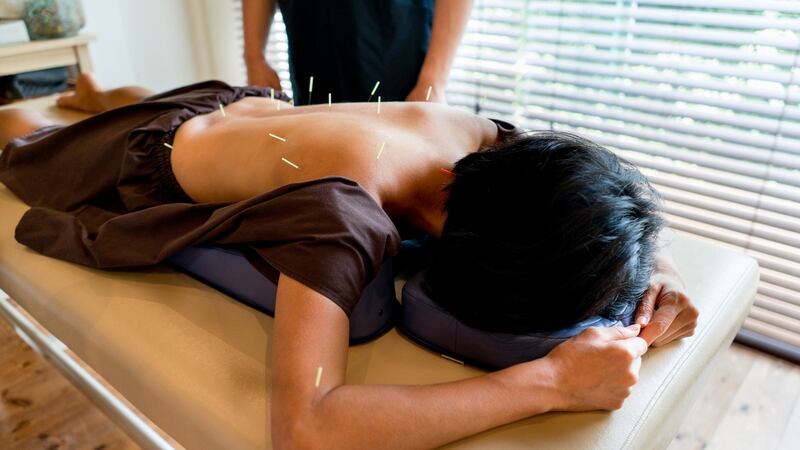What is it?
Acupuncture is part of traditional Chinese medicine. Although it is considered an ancient art, originated thousands of years ago, its first mention is in a manuscript dating to 200-100 BC. Traditional Chinese medicine incorporates the concept of Qi or Chi, a primeval energy that flows inside the body through 12 distinct meridians or channels. Within the frame of this concept, disease results from interrupted, hampered or imbalanced Qi flow, which can be restored to normal by the placement of needles on specific points along the meridians. Qi is specific to every different person, so two people with the same symptoms may not be treated in the same way.
There is no scientific evidence to support the existence of Qi, meridians or imbalance of energy as a cause of disease. However, there is evidence that something happens when the needles are inserted: there appears to be a release of chemical compounds that act on our nervous system, like the release of endorphins following activities that give us pleasure. This might explain why many patients report beneficial effects even though clinical tests do not show any improvement in their disease.
Is it safe?
Acupuncture is generally considered a safe technique as long as sterile needles are used by a trained practitioner. The most common side effects are infection – resulting from poor sterilisation or practice – and pneumothorax, or perforation of the space between the lung and the chest wall. However, these are rare when the needles are manipulated by a trained practitioner.
What does the evidence say?
Because traditional Chinese medicine believes most diseases stem from imbalanced energy flow, acupuncture is recommended for all sorts of ailments, from pain to allergies and anxiety. However, clinical trials do not support all of these uses.
A problem with acupuncture testing in clinical trials is the difficulty of finding an effective placebo – a treatment that doesn’t have a therapeutic effect – to compare it with. Clearly, a patient is aware of needles being inserted so comparison with a sugar pill is not appropriate. Researchers have then used what they call “sham” acupuncture, using needles inserted at points that have nothing to do with meridians, or that do not penetrate the skin as much as real acupuncture demands. Interestingly, most clinical trials that have found beneficial effects of acupuncture compared to no treatment have also found no difference between the effects of real and sham acupuncture. This suggests that beneficial effects are derived from the insertion of needles have nothing to do with Qi or meridians, but with the effects of chemical compounds released following treatment or the placebo effect.

In spite of many different treatment types used, the effectiveness of acupuncture can be evaluated – at least for some applications – because of the wealth of information available on it: there are tens of thousands of scientific articles studying the effects of acupuncture. Most of these are considered of poor quality because they do not incorporate placebo controls and/or the patients and researchers were not blinded about who was receiving which treatment. For these reasons, the best evidence comes from systematic reviews, which analyse many different clinical trials together.
Systematic reviews have found very small analgesic effects of acupuncture; this could be due to the difficulty in collating results from trials using different treatment schedules and types. In spite of this, a large review incorporating 22 trials with more than 4,000 patients suffering from migraine found that the efficacy of acupuncture was at least similar to that of preventive drug treatment; in this analysis, 10 out of 14 studies found no difference between the effects of true and sham acupuncture.
Another large review of 13 trials and more than three thousand patients suffering from different pain conditions found significant differences between acupuncture and non-acupuncture treatments; nevertheless, the same study again found negligible differences between real and sham acupuncture in all of the studies analysed. Findings also show that acupuncture is effective in short-term management of pain, with little or no long-term benefits.
Systematic reviews carried out by the prestigious Cochrane researchers group found acupuncture to have beneficial effects against migraines, neck pain, tension-type headaches, and peripheral joint osteoarthritis. In this analysis, the effectiveness of acupuncture against sham acupuncture was significant but very small (a difference of about 0.5 in a 0-10 pain scale). Cochrane reviews did not find sufficient good quality evidence to establish the effectiveness of acupuncture for other pain conditions (rheumatoid-arthritis related pain, shoulder pain, low back pain and lateral elbow pain).
Aside from pain management, acupuncture has been prescribed for numerous disorders, from Parkinson’s disease to anxiety. However, no effectiveness has been shown for acupuncture in these applications: at best, the results are inconclusive due to poor study design and biased analysis of results (small patient numbers, no placebo control, no blinding), and more rigorous data is needed before effectiveness can be established. There also appears to be a correlation between low quality of the study and reporting of beneficial effects of acupuncture.
Conclusion
Acupuncture has shown very small beneficial effects in the treatment of certain types of pain, although it does not appear to improve the underlying causes of the pain (for example joint damage in arthritis). These are likely due to the placebo effect or to the chemicals released following needle insertion, since most studies show comparable effects of real and sham acupuncture. For other disorders, there is not enough evidence to support the fact that acupuncture is more effective than placebo.
Acupuncture performed by trained specialists has few side effects and is unlikely to interfere with conventional medicine therapies.
Alternative therapies
- What the evidence says
- Acupuncture
- Chiropractic
- Homeopathy
- Reiki
- Aromatherapy
- Why people use alternative therapies










